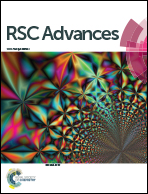Preparation of crosslinked porous polyurea microspheres in one-step precipitation polymerization and its application for water treatment
Abstract
Porous polyurea microspheres (PPUMs) were prepared in one-step by the precipitation polymerization of isophorone diisocyanate (IPDI) in a water–acetone solvent. Monodisperse SiO2 particles were added before polymerization and etched by a crosslinking agent triethylenetetramine (TETA), which led to the arrangement of the pores on the crosslinked polyurea microspheres' surface. Another method was also tested for the synthesis of PPUMs, in which non-crosslinked polyurea/SiO2 composite microspheres were synthesized first, and the SiO2 nanoparticles were then etched away. Compared to the second way, the one-step method is simple and efficient. The crosslinked PPUMs showed excellent hydrophilicity. The influence of the amounts of SiO2 nanoparticles, TETA, and the size of SiO2 nanoparticles were studied. The adsorption tests for iodine and methyl orange (MO) dyes in water were carried out, which showed that the as-prepared crosslinked PPUMs possessed great adsorption performance.


 Please wait while we load your content...
Please wait while we load your content...